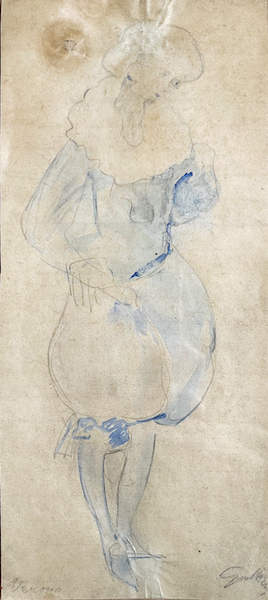Biography
Between 1900 and 1901 he studied at the Model Drawing School, where his masters were Ede Balló and Antal Lóránfi. In 1902 he spent a few weeks in Rome and then a longer period in Florence. From 1902 his works were regularly exhibited at the National Salon. In 1906 he went to Paris and from then on he travelled frequently, mainly in Italy. His art was inspired by small Italian towns and artists such as Giotto, Botticelli and Alessandro Magnasco. In 1905, he made set and costume designs for the Thália Company for L. Alma Tadema's play The Invisible Governor. In 1907, he exhibited nearly a hundred of his works at the Uránia art gallery in an exhibition he organised with Ödön Márffy at the Uránia Art Gallery. The following year he was awarded the Franz Joseph Prize of 4,000 crowns and took part in an international exhibition in London, but his foreign appearances went unrecognised. In June 1909, he exhibited his works in Oradea, alongside works by József Rippl-Rónai, Károly Kernstok, Róbert Berény, Dezső Czigány, Béla Czóbel and Lajos Tihanyi. In the same year, he had a joint exhibition with Dezső Fáy at the Uránia Hall. Between 1908 and 1910 he participated in the exhibitions of MIÉNK, but only as an invited guest artist, not as a full member. It was during this period that he produced his works inspired by the Rococo, especially Watteau, which he himself called 'Biedermeier entertainments'. The fairyland of Na' Conxypan, which he created in his imagination, is depicted in his short stories, and life there is captured in his paintings. On these canvases, grotesque human figures populate a small-town setting in northern Italy. In 1911 Gulácsy exhibited his paintings again in Oradea. The following year, he did not participate in any public exhibitions, but had his show in the studio of the photographer Dénes Rónai. The material shown here was then exhibited in rural towns of Szeged, Békéscsaba, Orosháza and Timisoara. In the same year, he made the sets and costumes for Strindberg's Swan Castle for the New Stage; the critics praised the play, especially Gulácsy's work. In 1914, the news of the outbreak of war reached him in Venice; he was hospitalised in a bad state of nerves and returned home to Hungary only in 1915. The worsening mental illness also led to a significant change in his painting. It was then that he produced his oil painting The Cliff of Death and his drawing La Guerra. The free composition and visionary images in these paintings made him a forerunner of Surrealism. In 1916, he exhibited five works at the National Salon in the Young People's Exhibition. He later joined the activists, became a member of the MA group and exhibited with them at their third exhibition in 1918. In his later years he made experimental expressionist drawings and works of simplified geometric forms. From 1919 he lived in a mental hospital and although a collective exhibition of his work was held in 1922, he was ill during the last decade of his life and was unable to work. He had a memorial exhibition at the National Salon in 1936, at the Bibliotheca Officina in 1947, at the Szent István Király Museum in Székesfehérvár in 1966, and in Kecskemét and Szekszárd in 1986. In the spring of 2023, the Hungarian National Gallery will show around 200 items of his works.

